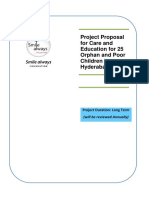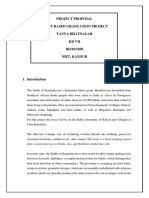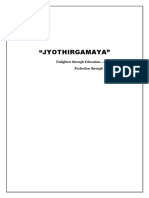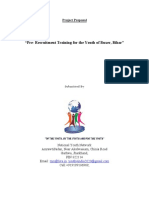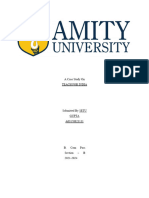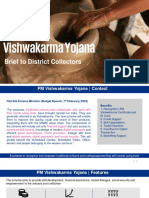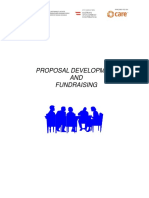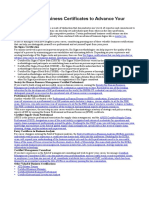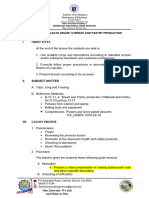Nath Sanskriti Seva Sansthan
Proposal
Hope Center for Education
“Remedial Education Support to students for building a educated India”
PROPOSAL BY:
Nath Sanskriti Seva Sansthan
1
Table of contents:
1. Problem statement...................................................................................2
2. Project overview.......................................................................................2
3. Project objective.......................................................................................2
4. Project deliverable....................................................................................3
5. Project plan...............................................................................................4
6. Reporting and project management.........................................................4
7. Key reporting indicators............................................................................5
8. Project outcome.......................................................................................6
9. Budget................................................................................................. 7
2
Problem statement:
The Primary education system running in government school requires substantial improvement.
Primarily the reason is the nonavailability of trained staff,proper classroom,urinals and students
studying in the vernacular medium faces huge challenges in higher education as primary
medium is English. These leads to higher drop out rates and poor learning outcomes,which
leads wastage of human capital.
A recent survey conducted by the community shows that:
● 70% have weak English proficiency
● 29% drop out rate among students
Additionally, students have limited access to quality educational resources and are often not
engaged in meaningful learning experiences that foster critical thinking, problem-solving, and
decision-making skills.
This situation results in a cycle of poverty, lack of literacy, and exposure to negative a habit
which limits their contribution to the nation's development.
There is an urgent need to provide access to education, skills, and support to these children to
help them overcome these challenges and achieve their goals.
Project overview:
The Hope Center for Education is a project aimed at providing remedial educational support
to children aged between 6-12 years for enhancing learning outcome and developing life skills.
The project aims to establish 50 Hope Centers of Education with a target to benefit 1250
students per year.
The Hope Center for Education will be a standard hub for peer learning, with access to books,
and will organize various activities to engage and develop the students.
The project adopts a participatory approach and seeks to involve all stakeholders, including
students and parents, in its activities.
Project objective:
The project aims to reach 1250 students over the course of 3 years and to improve their
educational outcomes through a combination of structured classes, hand on learning
activities, and practical experiences with the following sub-objectives:
1. Sensitize children toward self and society by improving knowledge
2. Set up giving them the hope and direction for a better future.
3
3. These centers will undertake various extra-curricular activities covering sports, music,
arts,teach good habits, health and hygiene that helps in developing the overall
personality of these students
4. The teachers at these centers will be appointed from within the village after a
recruitment process that involves knowledge and teaching skill set assessment and
includes a one-week teaching skill facilitation by a competent faculty creating jobs for
local women community.
Target Group: Age between 06-12 years Location : Mumbai,Thane & Palghar in Maharashtra state
Number of Beneficiaries: 1250 students in a year Duration of Project- 3 Years
Project deliverable:
Remedial education that integrates English language, life skills, and extra
curricular activity
Establishment of a fully equipped classroom
Implementation of a year long program for each c e n t e r s , with a focus on
hands-on and experiential learning.
Conducting pre and post-tests to measure student progress and impact
Snacks distribution once a week for healthy nutrition
Parent teacher meeting to follow up on the progress of students
Project plan:
The project plan for Hope for Education Room can be divided into the following phases:
Phase 1:Preparation and Planning (1-2 months)
● Develop a detailed project plan including goals, objectives, activities, budget, timeline,
and resource requirements.
● Identify potential resources,involve stakeholders, and manpower for the project.
● Assess the community needs and conduct a baseline survey to determine the best location
establishing these centers
● Involve the local village panchayat members important government department
stakeholders to have the necessary support for successful implementation of the project
4
Phase 2: Implementation (3-6 months)
● Set up the physical infrastructure for the Hope center of education , including
equipment, furniture, and supplies.
● Recruit and train teachers, coordinators, and volunteers.
● Develop and distribute materials to raise awareness about the project and attract
students.
● Inaugurate the Hope center of Education and begin offering classes, workshops, and other
activities.
● Monitor the progress of the project and make any necessary adjustments to ensure it
is meeting its goals and objectives.
Phase 3: Evaluation and Refinement (6-12 months)
● Assess the impact of the Hope For Education centers on the participating students that
includes their improved skills, attitudes, and knowledge.
● Collect feedback from students, teachers, and other stakeholders to identify areas
for improvement.
Phase 4: Expansion and Replication (12 months and beyond)
● Based on the success of the Hope for education center, consider expanding it to
other communities and replicating it in different regions.
● Share best practices and lessons learned for expansion to other locations
● Continuously monitor and evaluate the project to ensure it is meeting its goals and
making a positive impact on the community.
This phased approach will help to ensure that the project is implemented effectively and
efficiently while allowing for regular assessments and adjustments to be made along the
way.
Reporting and project management plan:
1. Project manager:
A designated project manager will be responsible for overseeing the entire project
and ensuring that it is completed on time, within budget, and to the required
standards.
2. Center Coordinator:
5
2 designated project coordinator will be responsible for overseeing 25 centers each
and ensuring that the teachers are regularly taking up classes and students are
coming on time .Also they would ensure that the quality of education is being
imparted to students and a gradual improvement is happening in the learning of
students.
3. Progress meetings:
Regular meetings will be held to review the status of the project and to identify and
resolve any issues that may arise. The project manager will chair these meetings, and
all stakeholders including the center coordinator, teachers, and donors will be
invited to attend.
4. Status reports:
The project manager will provide regular status reports to all stakeholders, which will
include details of project progress, budget and issues. These reports will be distributed
on a monthly basis and will provide a comprehensive overview of the project’s status.
5. Budget tracking:
The project manager will be responsible for tracking the project budget and ensuring
that it remains within the approved limits. Any significant variances from the budget
will be reported to stakeholders and the cause of the variance will be addressed in
close coordination with the donor agency.
6. Stakeholder management:
The project manager will be responsible for engaging with stakeholders and ensuring
that their expectations are managed effectively. The project manager will provide
regular updates to stakeholders, respond to their queries and concerns, and engage
with them to resolve any issues that may arise.
7. Project documentation:
The project manager will be responsible for maintaining accurate and up-to-date
project documentation, including project plans, status reports, risk assessments, and
other relevant project documentation.
8. Project closeout:
Upon completion of the project, the project manager will prepare a final report
summarizing the project’s outcomes and lessons learned. The final report will be
6
distributed to stakeholders, and the project will be officially closed.
Key reporting indicators:
The key reporting indicators for the Hope for Education Center project could include:
1. Attendance rate: The number of students who regularly attend the classes and
activities
2. Improvement in reading habits: The number of students who have developed an
interest in reading and are engaging in it regularly.
3. Life skills improvement: The number of students who have acquired life skills, such as
spoken English, leadership, and interpersonal skills, as a result of the classes offered.
4. Enhanced proficiency in subjects - Advance,Intermediate,Basic & Beginner levels
assessment & course correction in subjects English,Maths,Hindi & General Knowledge
5. Improvement in critical thinking, problem-solving, and decision-making skills
(measured through assessments and teacher observations)
6. Crack exam for scholarship & admission to prestigious institutes of repute.
National Means-Cum-Merit Scholarship & Jawahar Navodya Vidyalaya other
scholarship for students from financially weaker background.
7. Development of teachers -Support to build capacity, improve the skills,
develop teaching techniques of teachers
These indicators will help assess the impact of the project and measure its success in
achieving its objectives.
Project Outcome:
The project outcome is to provide children of the community with the hope to lead a
healthy, dignified lives and in long run contribute towards the nation development.Corporate
would get the branding at all the centers,regular visit to all the centers and will also get
complete support to undertake volunteer activities.
The project will aim to achieve this outcome by providing various classes and workshops that
focus on improving knowledge, , building life skills and changing attitudes. The Hope Centre
of Education will be a standard hub of learning where students can read, write, learn,
enjoy, discuss, help, and share.
7
Budget:
The monthly and yearly budget for Hope Center for Education for First Year
Cost Head Description Number of Cost per Cost per Annual
units unit Month cost
(INR) (INR) (INR)
Operational cost (A)
1. Project Manager Project Manager 1 75,000 75,000 9,00,000
Salary
2.Center Coordinator Salary of Centre 2 20,000 40,000 4,80,000
coordinator
3. Teachers (50) Salary of 50 50 10,000 500,000 60,00,000
teachers
4. Conveyance,Food & Conveyance,Food & Monthly 30000 30000 3,60,000
Travelling expenses Expense travelling expenses
of Project Manager
& Coordinator
5.Printing & Stationery Notebooks,Pencil,P Monthly ( 50 500 25000 3,00,000
charges en,other item Centers)
6.Students Refreshment One dry snack once Monthly ( 50) 500 25000 3,00,000
a week
7.Miscellaneous expenses Any item required Monthly (50) 300 15000 1,80,000
in case of
emergency use
(Drinking
Water,Toilet
Items,Others as per
requirement)
6. Mobile Expenses Monthly mobile Monthly 1000 1000 12000
expense for all
Project
Coordinator &
Project Manager
7.Rental Cost for Rental cost for 50 Monthly 12000 600000 7200000
taking one room at centers
each location
8
Total (A) 13,11,000 1,57,32,000
Capital Cost (B)
1. Dari , Black Board & Classroom 50 Classroom Total Cost for developing One Center will
Stand, Chair & Table for be Rs 50,000 in which all the items which
teacher only, Tube lights has been mentioned will be procured
& Fans as per
requirement
Total cost for developing 50 centers will be
2. Library Almirah/Books Classroom 50 Classroom Rs 25,00,000 -/-
3. Note Books / Classroom 50 Classroom
Stationary / Charts
4. Classroom 50 Classroom
5. Sign Board / Branding Outside the setup 100 No’s
6. Uniform & Students 1250 No’s
Bags
Total ( Cost A+B ) 1,82,32,000
Add: Administrative For administrative purposes which would include 27,34,800
costs (15% of reporting,regular updates on progress,book
project cost) keeping,accounting,record keeping and maintaining all the
record as per government guidelines
Grand total (Rs) 2,09,66,800 -/-
Thanks


